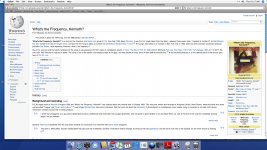The initial questions were about the coiling of microphone wire and how it made the sound terrible due to the increased inductance caused by the solenoidal currents within the twisted pair.
I thought initially the audio technician said the sound was better when the mic leads were coiled. So I thought we were looking into ANY possible explanation as to why this might or might not be possible.
I trust Stereophile to give me ACCURATE RELATIVE RESULTS compared to my competition that is measured in the same way.
So then, your desire is to continue the "drunkards walk", randomly trying to build things, making up wild theories as you go along, talking down to others about "this is how we high falutin guys do things", without regard to actual engineering?
I hope people never learn how to do things your "way", as you are clueless as to why your product doesn't "sound" as good as others, even if you bench test them...
Your confusion is yours alone..I pray others do not follow your non-engineering, non scientific path.
If you mean, as teh kit was delivered, there is no question that was not good. When I received them, I dropped them into 3RU cases with fans and a heatsink tunnel, I'm no dummy.It sure beats a SW Products power amp. '-)
I ran 8 of them far into clipping 42 hours per week for at least 3 years. Not one failed.
The circuitry quality, other than two schematic mistakes, was quite impressive. I could hear the meter indicators hitting the top stop in beat to the music, nary a failure. EVER.
That's quality.
jn
Oh, btw. tested a mike cable from 20hz out to 500Khz, absolutely no difference between coiled and straight.
I'd post details, but you wouldn't read them anyway.
jn
I thought initially the audio technician said the sound was better when the mic leads were coiled. So I thought we were looking into ANY possible explanation as to why this might or might not be possible.
Sigh, I love those anecdotal accounts. So scientific. Ed talked about a coiled mike sounding bad...I thought the initial also said that...
jn
Details please! Don't repeat your admonitions of us in your own testing. '-)
What wire? How long? etc.
What wire? How long? etc.
Why should the details of my test be of any importance to you. YOU DIDN'T ASK FOR ED'S DETAILS, SO WHY BOTHER ASKING ME???Details please! Don't repeat your admonitions of us in your own testing. '-)
What wire? How long? etc.
jn
'sides, I'm busy putting it into a spreadsheet.
Where are your numbers?
I don't post numbers.
I post details.
Don't get your panties in a dither, dude. I told you, I'm putting it into excel.
So put a cork in it.
jn
What a simplistic question.I thought that you were a measurement wonk SY? What is the frequency, SY! '-)
frequency, as in one single test frequency?
Are you nuts?
jn
@jn
Just searched galleries for your quoted input. Search function shows no result!
On your personal pages there are two thumbnails as mentioned but these do not open: the thumbnails are illegible.
Just searched galleries for your quoted input. Search function shows no result!
On your personal pages there are two thumbnails as mentioned but these do not open: the thumbnails are illegible.
I do not know what happened. I'll try again.@jn
Just searched galleries for your quoted input. Search function shows no result!
On your personal pages there are two thumbnails as mentioned but these do not open: the thumbnails are illegible.
John, we've been "through" for years..😀I am having a 'meaningful' discussion with SY. I thought that you and I were through. '-)
jn
I thought that you and I were through. '-)
Buy him flowers and a nice dinner, talk nicely, and I bet you two lovebirds can patch things up.
I do not know what happened. I'll try again.
Nothing happened, it's all there. Perhaps Brian didn't click the "photos" link or on the thumbnails which open those Gallery sections?
Nothing happened, it's all there. Perhaps Brian didn't click the "photos" link?
I can't even see them. All I get is a no thumbnail in the pic, then no pic.
I'll work on it. meantime, here's the jpg's.
The first is the inductance of the cable coiled and uncoiled. The terms Ls min and Ls max refer to the upper and lower readings on the meter, it was bouncing around because it's at the lower limit of the machine's resolution and it's a noisy environment. I missed some data points in my rush to keep jc from wetting his pants.., excel doesn't draw a line through a missing point. Note that between 100Khz and 200 Khz, it starts to drop due to proximity effects on a 22 guage wire. Note that the bulk of the data actually is there. The values are so close that excel actually draws one curve over the others..
During this entire run, I measured the coil free air and then placed a 4 inch diameter 4 inch tall stainless cylinder in the middle to check for solenoidal fields. At no time did the reading change.
The second is the resistance comparison between coiled and straight. Again, no surprises.
The third is a check to make sure that solenoidal fields can be detected within the coil via the insertion and removal of the stainless cylinder. For this test, I used only the wire in the cable connected to pin 2 of the xlr, giving me essentially a solenoid. The meter was sensitive enough to determine when the stainless was put into the coil, but only at frequencies above 100 hz. the effect of the stainless is to exclude the time varying field, so the inductance goes down as a consequence. Also, the resistance will go up as a consequence of eddy dissipation, shown in the fourth pic. Note the machine is incapable of determining eddy losses as opposed to proximity resistive increase.
jn
Attachments
-
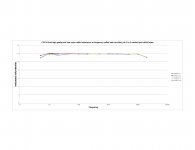 CES 50 foot high grade prof low noise cable inductance vs frequency coiled and uncoiled, pin 2 t.jpg109.6 KB · Views: 245
CES 50 foot high grade prof low noise cable inductance vs frequency coiled and uncoiled, pin 2 t.jpg109.6 KB · Views: 245 -
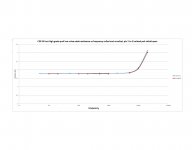 CES 50 foot high grade prof low noise cable resistance vs frequency coiled and uncoiled, pin 2 t.jpg110.8 KB · Views: 239
CES 50 foot high grade prof low noise cable resistance vs frequency coiled and uncoiled, pin 2 t.jpg110.8 KB · Views: 239 -
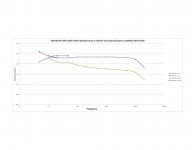 CES 50 foot mike cable coiled inductance pin 2 only for true solenoid open vs stainless steel in.jpg111.9 KB · Views: 231
CES 50 foot mike cable coiled inductance pin 2 only for true solenoid open vs stainless steel in.jpg111.9 KB · Views: 231 -
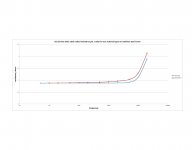 CES 50 foot mike cable coiled resistance pin 2 only for true solenoid open vs stainless steel in.jpg103.7 KB · Views: 233
CES 50 foot mike cable coiled resistance pin 2 only for true solenoid open vs stainless steel in.jpg103.7 KB · Views: 233
Last edited:
The same result repeated means the experiment is consistent. It doesn't necessarily imply that the experiment is useful and measuring what the experimenter wishes to measure.john curl said:Except, when the same results occur repeatedly at a specific measurement session. Then the 'random number generator, has a PATTERN.
- Status
- Not open for further replies.
- Home
- Member Areas
- The Lounge
- John Curl's Blowtorch preamplifier part II
